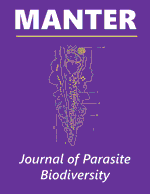Parasitology, Harold W. Manter Laboratory of

MANTER: Journal of Parasite Biodiversity
Date of this Version
9-12-2016
Document Type
Article
Citation
MANTER: Journal of Parasite Biodiversity (September 12, 2016) number 5
doi: 10.13014/K2VD6WCX
This paper was part of a symposium on mammal parasite biodiversity, organized by Scott Gardner and Jorge Salazar-Bravo, “CLM20 — Zoonosis y mamíferos Neotropicales” [Zoonoses and Neotropical Mammals], presented at III Congreso Latinoamericano de Mastozoología, Bogotá D. C., Colombia, 1 al 5 de diciembre del 2015
Abstract
Anthropocommensal rodents live in close proximity to humans in many habitats around the world. They are a threat to public health because of the pathogens they carry. Recent studies in Mérida, Yucatán, México, have shown that commensal rodents harbor potential zoonotic pathogens such as bacteria, helminths, and viruses. In this study, we describe reproductive and demographic parameters of house mice and black rats present in households from Mérida, Yucatán, México, a municipality located in a tropical region in southern México. Rodents were trapped in 142 households within the municipality of Mérida from 2011 to 2014. A total of 832 rodents were trapped, constituting 556 (66.8%) house mice (Mus musculus) and 276 (33.2%) black rats (Rattus rattus). The sex ratio in mice was different than parity, while in rats it was 1:1. Mice in the weight class 8.1–12 g were most abundant in both females (52.9%) and males (57.2%). On the other hand, rats weighing ≤ 40 g (25% of females and 28.6% of males) were most abundant. The percentage of pregnancy in mice was 46.7%, whereas in rats it was 21.3%. The mean number of embryos was 4.7 and 5.8 in mice and rats, respectively. This study provides relevant demographic information on the ecology of commensal rodents from a tropical region of Latin America. We consider that our findings could be useful as a first step toward understanding the ecological behavior of rodent populations in tropical regions.
Included in
Biodiversity Commons, Other Animal Sciences Commons, Parasitology Commons, Population Biology Commons, Zoology Commons


Comments
Copyright © 2016, Panti-May, Hernández-Betancourt, Torres-Castro, Machaín-Williams, Cigarroa-Toledo, Sodá, López-Manzanero, Meza-Sulú, and Vidal-Martínez
License: CC BY-NC-SA 4.0 International
The archive of record for nomenclatural acts in this journal is the Internet Archive